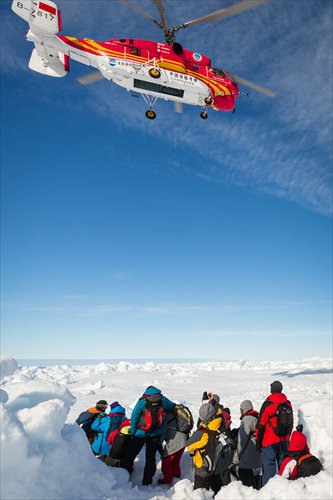HOME >> CHINA
Chinese rescue boat may be caught by heavy Antarctic ice
By Agencies – Global Times Source:Agencies - Global Times Published: 2014-1-4 0:48:01

A helicopter from the nearby Chinese icebreaker Xuelong hovers above passengers from the stranded Russian ship Akademik Shokalskiy on Thursday. Photo: AFP
The Chinese icebreaker Xuelong, which came to the rescue of a Russian ship stranded in the Antarctic, helping evacuate dozens of passengers, has signaled it may now be trapped in heavy ice, according to the Australian Maritime Safety Authority (AMSA) on Friday.
The Xuelong has not moved for several days as it was taking part in multiple attempts to rescue passengers on a scientific expedition aboard the Russian vessel Akademik Shokalskiy.
AMSA said in a press release on its website that Xuelong notified it "at 1 pm AEDT on Friday it has concerns about their ability to move through heavy ice in the area."
The Aurora Australis, an Australian government supply vessel, has been placed on standby by the AMSA's Rescue Coordination Center Australia (RCC Australia) to remain in open water in the area as a precautionary measure.
The Xuelong has advised RCC Australia that it will attempt to maneuver through the ice when tidal conditions are most suitable during the early hours of Saturday.
"There is no immediate danger to personnel on board the Xuelong," said AMSA.
On Thursday, a helicopter from the Xuelong used a makeshift landing pad next to the marooned ship to ferry 52 scientists, tourists and journalists to the Aurora Australis.
The rescue mission was beset by extreme conditions from the start, with the Xuelong and Aurora Australis both unable to break through the ice to free the stranded Russian ship, despite several attempts.
Rain, snow and wind had also delayed plans for the helicopter rescue mission.
"This one was quite difficult to do," said John Young, general manager of the AMSA's emergency response division.
"All Antarctic operations are difficult just because of the nature of the place and in this particular case the movement of the ice and the changing of the weather introduced their own complications."
The 52 passengers were shuttled to an ice flow near the Aurora Australis, the Australian Antarctic Division's supply ship, over four flights across on Thursday.
Expedition leader Chris Turney said the evacuation was carried out "with good grace, humor and professionalism, while also bringing food supplies back for the Russians."
"The helicopter voyage over some 14 nautical miles (26 kilometers) of jagged, broken sea ice just reaffirmed to the team how massive the ice breakout must have been that trapped us," he said.
The complicated rescue has prompted questions about the cost of the mission and whether ships should be allowed into Commonwealth Bay, where the Russian scientific research vessel became trapped.
AMSA said the costs would broadly fall to the ships involved, and it would attempt to hold a briefing with all those involved in the rescue, but that any inquiry into the conduct of the Akademik Shokalskiy would have to be addressed by Russian authorities.
"Lessons learned from those processes may be fed into the International Maritime Organization, and the guidelines and rules it creates for polar operations which is quite an active subject... at the moment," Young said.
AMSA has said the Akademik Shokalskiy, which still has 22 crew members on board, would attempt to free herself when circumstances permitted.
Agencies - Global Times
Posted in: Society